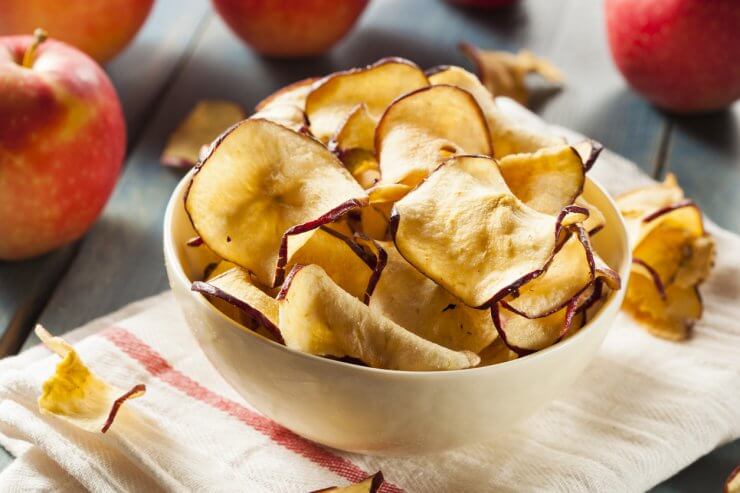
Fresh apples are divine but what if you can’t eat them fast enough? At room temperature, fresh apples will last about a week. Then they start to get bruised and mealy. Stored in the fridge, apples will keep for about a month or two depending on the variety. Sure, you can learn how to freeze apples and can apples. But if you learn how to dehydrate apples, you can keep them for up to 6-12 months. And while you could shell out some moolah to buy an electric food dehydrator, you can easily learn how to dehydrate apples in the oven. Plus, you won’t have to find a storage spot for yet another kitchen gadget.
Why dehydrate?
Before getting to the “how,” let’s start with the “why.” Why do we dehydrate foods and what is the science behind dehydration? The word “dehydrate” literally means “to remove water.” Food dehydrating involves the removal of moisture from food items. The reason foods spoil and rot is because bacteria have access to moisture which keeps them alive. By removing the bulk of the moisture through dehydration, bacteria will not be able to survive and food will not spoil as quickly.
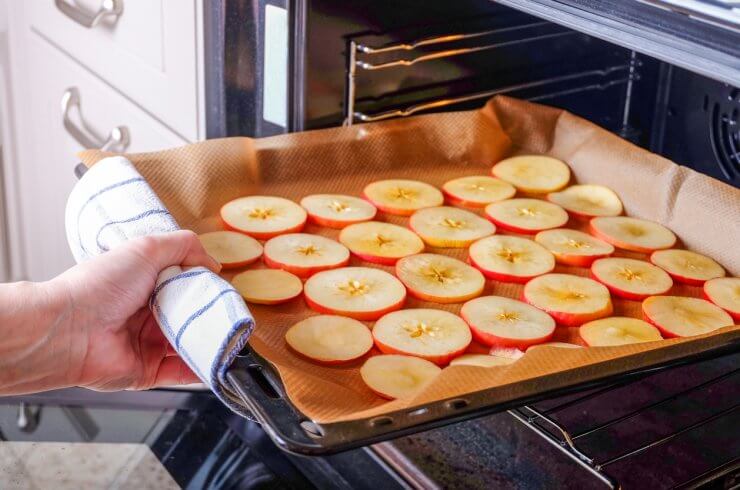
How to dehydrate apples in the oven
Ingredients and materials needed:
- fresh apples (any variety!)
- cutting board
- sharp knife
- baking sheet(s)
- parchment paper or silicone baking mat
- oven
- cinnamon (optional)
Directions
- Preheat oven to 230 degrees Fahrenheit. We’re going low and slow when it comes to dehydrating fruit.
- Cut apples into thin slices. You don’t have to peel or core apples but be sure to remove any seeds. (Note: you can use a mandoline slicer if you have one, but be careful not to cut the apples too thinly. Slices that are too thin can burn.)
- Place slices on a baking sheet lined in parchment paper or a silicone baking mat. Try not to overlap the slices since that will impact the drying process.
- Optional: sprinkle cinnamon on one side of apple slices. Don’t worry, you’ll get the other side later on!
- Bake the apples for one hour. Remove and flip the slices over. Sprinkle cinnamon on the other side.
- Bake the apples for another hour. When time is up, leave the baking trays in the oven and turn the oven off. Let the trays cool completely. This may take up to two more hours, but this step helps give your dehydrated apples their crispiness.
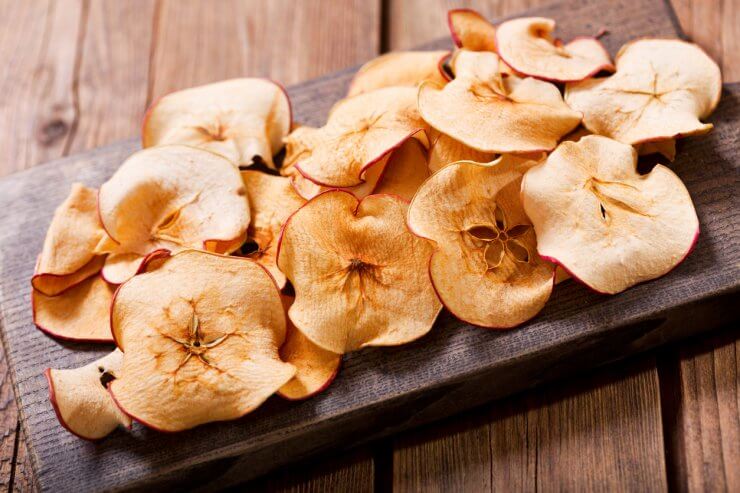
How should you store them and for how long?
Store apple chips in an airtight container or sealable plastic bag. Remove any extra air, when possible. Depending on how much moisture you remove, dehydrated apples can last up to a year but only if they are sealed properly. Air and moisture will affect your apple chips, so if you aren’t using a vacuum sealer I recommend enjoying them within a week or two.
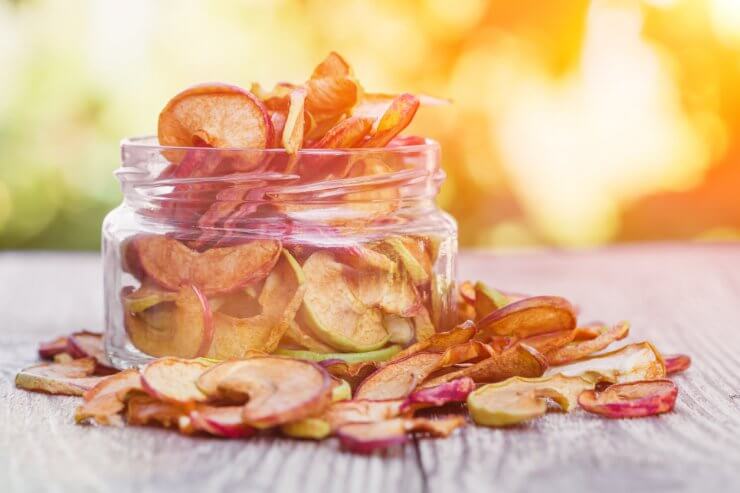
Optional preservation steps
In addition to the optional cinnamon flavor, you may also choose to dip your sliced apples in citric acid or lemon water. The citric acid or lemon mixtures slow down oxidation, a process where enzymes turn apples brown. Treating apples with citric acid or lemon water adds an antimicrobial property to the apple chips which can help prevent E.coli bacteria. I recommend adding this step if you plan on storing your chips for longer than a week.
To use citric acid:
Mix ½ teaspoon of citric acid powder with 2 cups of water. Add sliced apples and soak for 10 minutes. Remove apples and rinse with clean water. Pat apples dry with a kitchen towel and arrange them on a baking tray. Follow remaining directions from step 3.
To use lemon water:
Mix 1 cup of bottled lemon juice with 1 cup of cold water. Soak sliced apples for 10 minutes. Remove apples and place them on a baking tray. Follow remaining directions from step 3.
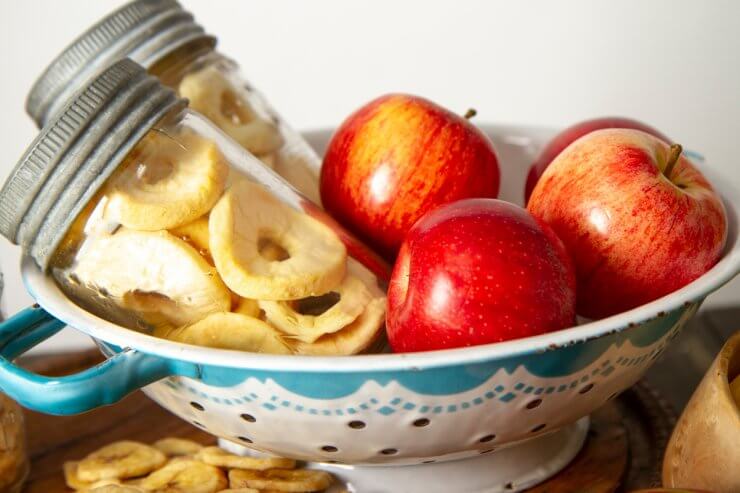
What’s the nutrition in dried apples vs. uh… hydrated apples?
Fresh apples only have 57 calories per cup. Dehydrated apples have 120 calories per cup. The reason behind the big difference comes down to density. A fresh apple has more density (or weight) than the same apple that has been dehydrated. In terms of satisfying hunger, a fresh apple will be more filling than a dehydrated apple because of the moisture content. You might feel satisfied after eating a fresh apple, but it will take three or four apples’ worth of apple chips to give you the same satisfaction.
Another major nutritional difference between fresh and dehydrated apples is fiber content. There are 4 grams of fiber in one cup of fresh apple slices. Whereas a cup of dried apples has 7.4 grams. Nearly double the fiber. This is important to remember, especially since too much fiber may cause stomach upset.
Whether you have apple trees in your backyard or enjoy seasonal trips to the local apple orchard, learning how to dehydrate apples in your oven is a great way to enjoy the delicious flavors of apples. I recommend using multiple varieties of apples and having a taste test with your friends and family. Dip apple chips in your favorite nut butter, chocolate hummus, or vanilla yogurt dip.
Have you already learned how to dehydrate apples in your oven? Share your tips and tricks in the comments.


 Previous
Previous


Also a passionate gardener, I’m very excited to be a part of the garden team this year again. There’s so much information out there and I’m really looking forward to seeing what happens with my garden this year. ????????????
Any suggestions on given birds, dehydrated apples?
Can this process be used for pears, nectarines, peaches etc?
Clarification for using lemon juice – do you dry the apples after soaking in the lemon water?
In your instructions of using citric acid or lemon juice, you say to dry apples using citric acid. Your instructions don’t say to dry using lemon juice. Is this correct?
Hi Mary, I didn’t make the lemon juice/citric acid part of the formal instructions because it’s really only necessary if you are making a large batch that you want to stay preserved for, say a month or longer. However, if you do plan to make a long-lasting batch, then the instructions for using lemon or citric acid would come after you slice them and before you begin the dehydrating process.